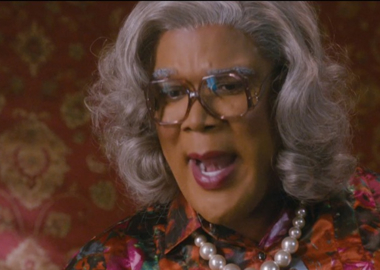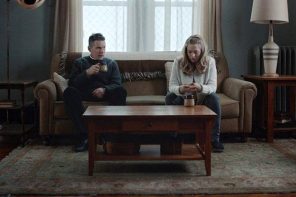A little over a month ago I drove an hour from my small town in Massachusetts to the closest big city, Albany, NY, to take my student Sevonna to see Tyler Perry’s Madea’s Witness Protection. I had thought she was well-prepared for what I call “the Perry film experience”—she had seen several of Perry’s previous films in the theater, and from her time in two of my courses (“Sacred Cinema: Black Religion and the Movies” and “Womanist/Black Feminist Thought”) I expected she was more than equipped to bring a theologically adept feminist lens to the viewing experience.
Once we started watching though, I noticed her shock at what she saw. What follows is our post-film conversation.
____________
Rhon: What was it exactly that took you by surprise?
Sevonna: Well, several things. Although very little from the previews suggested Madea’s Witness Protection would be any different from a typical Perry production (all of Perry’s films and plays centralize the importance of the black family and faith in God), I thought he would have stayed consistent with his previous themes. I didn’t anticipate his switch in direction from his predominately black audience to appease a white audience.
I think we both knew we were in for a treat, but were not prepared for the terrible taste it would leave in our mouths—I expected to see a new plot with old messages but instead I was perplexed by a painful glimpse of Perry’s money-making machine.
To describe Perry’s enterprise as a financial force in its own right is not at all an oversimplification. To date, Perry’s thirteen films, which include Diary of a Mad Black Woman (2005), Madea’s Family Reunion (2006), Why Did I Get Married (2007), and For Colored Girls (2010), have made just under $650 million.
Once we consider his New York Times bestselling book Don’t Make a Black Woman Take Off Her Earrings, his television series (House of Payne and For Better or Worse), and where he first got his start—his Chitlin’ Circuit stage plays—it becomes clearer how Perry’s empire is a billion-dollar industry. But many people (mostly white people) still do not know who he is!
That is especially surprising because of how he has been publicly endorsed by Oprah Winfrey (with whom he also co-produced the academy-award winning film Precious), how he has repeated annual entries on Forbes “Top Entertainer” lists, and how he is viewed as a “hero” to conservative radio host and commentator Glenn Beck.
Tyler Perry is a staple for better or worse (no pun intended) in black communities, and he is making a lot of money through the marketing of a very specific theological message—a message that was really painful to witness in this most recent film.
It’s a message that is navigated by Perry’s preposterous plot structure. In Madea’s Witness Protection George Needleman (Eugene Levy) is the CFO of a Wall Street investment firm. George unwittingly discovers that his company is a cover for a mob-backed Ponzi scheme, and this knowledge forces him to enter his family into the witness protection program. His stay-at-home wife Kate (Denise Richards), their bratty teenaged daughter Cindy, pre-pubescent son Howie, and his senile mother Barbara are sent by Needleman’s attorney Brian (Tyler Perry) from the suburbs of New York to hide in a place not even the mob would think to look—in Madea’s (also Tyler Perry) Georgia home.
As the unaware and reluctant witness, George is forced to figure out how his company pilfered millions of dollars.
The black church is important to the storyline. A frantic Jake Nelson, who invested funds in George’s company to raise money for his father’s church, finds out from Brian that the company was a scam. Jake then scrambles to get the money back before his father announces the not-so-good news to the congregation.
Ironically, it is through a revelation in the neighborhood church that George figures out the scheme behind his company’s fraudulent investments. George determines that he can restore the funds to the most deserving investors, including Jake’s church, but only with Madea’s help.
In a cinematic gesture to the ’90s blockbuster Ghost, Madea goes to New York City under an assumed identity to transfer millions of dollars from offshore accounts back into the accounts of thirteen investors. Thanks to Madea, George salvages his damaged career, and the Needleman dysfunctional family dynamics take a turn for the better as they learn the importance of faith and love in the process.
As someone who has recently gained a more critical understanding of the intersections of religion and popular culture, I also looked forward to Perry’s new film because I wanted to see how his theological message of hope and faith would sustain his new efforts to address a global concern: the financial crisis.
But the centralizing of the white family—which is a departure from Perry’s traditional filmic presentation—not only distanced Perry from his usual target audience of African Americans, it placed large servings of parody, caricature, and stereotype on a platter for white audiences to devour. I was really, really uncomfortable watching this film.
The question then becomes: what is so disturbing about Perry’s new strategy?
Perry’s audience shift dismisses the deeply-rooted history of racism in black entertainment—a history that is especially tricky when we look at the implications of black performance targeted for or at white audiences.
In the film, George has an epiphany in the community church, which becomes a parody of someone ‘catching’ the Holy Ghost—a moment that is at the very least sacred within black church traditions. The sounds of the Hammond B3 organ ride beneath George’s sanctified revelation, and could be considered one of the few familiar chords in the soundtrack for Perry’s predominantly black audience.
The film injects black popular cultural references, including remarks on Oprah Winfrey’s fame, Michael Jackson—and by mocking Aretha Franklin. Omitting the usual echoes from The Color Purple and TV shows like Good Times, Perry also shifts gears in reference to the movie Ghost and the television series The Golden Girls to appeal to a very specific—namely white—audience. Perry’s historical amnesia is really dangerous.
I’m especially intrigued by Perry’s centering of the white family, which echoes your point about historical amnesia. Although Perry drives home the theme of repairing broken families, he takes an unexpected turn that subtly redirects his framework. The white family in this film faces problems distinct from the issues concerning black households in the previous Madea franchises.
Instead of addressing dilemmas such as drug use, adultery, or sexual and physical abuse, Madea’s Witness Protection focuses on the problem of transitioning from wealthy to suddenly poor, how to properly do yoga, and the value of teaching one’s son how to play baseball—issues that are presented as characteristically “white.”
Even with the white family structure as the main course, Perry’s recipe remains on the table: he relies on popular culture references to lure specific audiences, he affirms the centrality of faith in oneself and in God, and he maintains the theme of repairing broken families. And at the same time, all of this is meant to be funny.
Perry’s messages are ongoing and slipped in between the laughs—and this time the misplaced dialogue and lulls—of the film.
And that we can see Madea as a prominent reinscription of the mammy figure really drives your point home, Sevonna. In Madea’s Witness Protection, she becomes the caretaker for the white family, she encourages the Needleman matriarchs to find their voices, and she even disciplines their children.
Interestingly enough, however, Madea never enacts violence upon the 15-year-old daughter who consistently disrespects her father and stepmother, nor does she physically discipline the lazy seven-year-old son who refuses to get out of bed for the breakfast that she prepared. This too is a departure from the standard practice of corporal punishment that is dished out handily in Perry’s films Madea’s Family Reunion, Meet the Browns (2008), and I Can Do Bad All by Myself (2009).
Perry’s double standard thus becomes clear: it is okay to physically punish a disrespectful black child, but never acceptable to enact violence upon a white one. Perry’s efforts to present a multicultural message of unity and sameness are disrupted by a more pronounced message of difference.
On the one hand, Perry’s “jumping the shark” is not at all surprising.
In my current project Pushing Weight: Religion, Popular Culture and the Implications of Image, I argue that the popular films featuring Madea are part of a collective of black, fat drag, comedy-dramas.
These films bear six distinguishing features: 1) they are considered “successful” because they gross more than their production costs; 2) they are accompanied by an R&B/gospel soundtrack, and 3) include casts of popular black actors and actresses who are well known within African American communities. Also characteristic of these films are 4) the use of multiple and arguably watered-down Protestant messages about the importance of faith in God, couched in comedic performance, to appeal to mass audiences. An additional feature is that 5) the black church is the space where a significant turning point and/or the film’s resolution occur. Most notably, these films are characterized by 6) the donning of intricately designed fat suits by black men (Tyler Perry, Martin Lawrence, and Eddie Murphy) to parody black women in the form of “sapphmammibel,” my term for the composite figure of sapphire, mammy, and jezebel inherent in their representations. Madea’s Witness Protection certainly fits this category.
It does, but the shock of this film, which is more intriguing than Perry’s seemingly new spin on his highly recycled formulas, is the ways in which Perry’s own philosophies and social commentaries are masked.
Perry positions himself as an advocate for a post-racial society when Madea supports Barbara’s enthusiasm about ‘Negro Spirituals’ ringing from the church down the street (while the rest of the family “overreacts” at her use—or misuse—of the word). Madea’s home and neighborhood serve as an introduction to black culture for the Needleman family, who enter a “museum for blackness” when they arrive at Madea’s house and experience the discomfort of plastic coverings on the sofa, or the inability to sit on the porch after certain hours.
Perry’s exhibitions are not much fun, to say the least, when the stereotypes based on black culture are what keep the plot moving. From Madea’s big breakfast with grits and fried ham, to Uncle Joe’s (also played by Perry) lesson on the Negro Baseball League and black male sexuality, Tyler Perry builds his characters’ relationships around stigmas and stereotypes.
In short, Perry hides behind Uncle Joe’s makeup and inside Madea’s fat suit to make regressive, racist, and sexist remarks on womanhood, sexuality, class distinctions, and violence—all couched in pseudo-empowering messages of love, God, and forgiveness. Perry’s cinematic recipe grants the opportunity for theaters full of knee-slapping audiences to laugh at things that are, arguably, not funny at all.
Madea’s Witness Protection preaches self-empowerment, the importance of putting family first, sacrifice, and that at times, it is even appropriate to “get damn angry.” Tyler Perry conveys these messages through multiple voices. Yet we cannot help but wonder if by the end of the film, once the audience sheds the prosthetics, whether or not they attribute the film’s messages to Perry, or to the many masks he hides behind. Perhaps both, but in the end, we don’t really know. While watching the film, our matinee audience of little more than a dozen shared varying, audible reactions to the film. While we were scowling, they were howling.
Our perspective was admittedly scholarly, yet the laughter from others in the theater suggested diminished spectator resistance to Perry’s troubling themes and stereotypes. In our view there is little that is liberative in Perry’s theological message, especially when hope and faith in God are couched in an outdated discourse that perpetuates negative stereotypes many have worked for a long time to disrupt.
Sadly, there is a lack of critical spectatorship—especially as Perry’s degenerative ideologies are hidden in plain sight.




